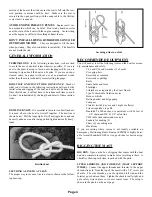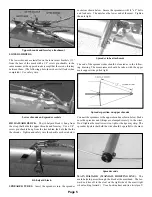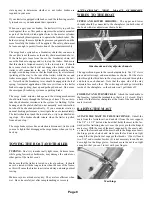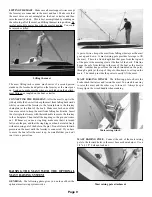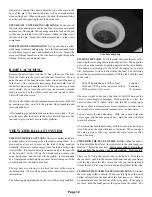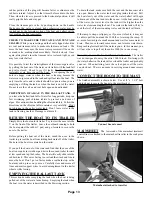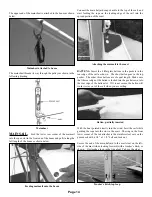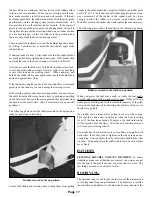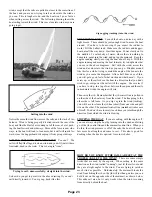
Forestay connection
Don’t release tension on the mast raising line until the forestay is
secure and the clevis pin and cotter ring are in place.
Tighten down on the turnbuckle so the rig is really snug. Then
secure the turnbuckle barrel with its cotter pins. Make sure the
cotter pins are spread to their full open position. Fold the pointed
ends back so they won’t cut hands or tear sails. One nice thing
about this setup is that you will not have to adjust the turnbuckle
after it is once set. The winch provides sufficient power to stretch
the rig enough to remove or install the pin. (This is the only dis-
connect that you have to make for raising and lowering the mast.).
LOWERING THE MAST.
To lower the mast, reverse the
process used for either the standard or optional system. First,
remove the boom. Before you lower the mast, put the mast sup-
port in its holder in the cockpit. Otherwise the mast will come
down on the cabin hatch and cause damage. Remember, the load
gets greater as the mast gets lower. Be prepared. Get a good grip
on the winch or mast. Don’t be fooled by the very small loads
while the mast is close to vertical. When the mast is down, hold
down on the base of the mast when you try to remove the hinge
bolt. It will want to pop up when the bolt is released.
People have been killed or badly injured as a result of sailboat
masts or support wires coming into contact with overhead power
lines. Be watchful whenever you rig, launch, trailer or do any-
thing else with your boat that might involve contact with power
lines. If there is a threatening power line anywhere near areas
where you sail, call or write to the power company and try to get
them to move it or bury it. Notify us and we will also lean on
them. Don’t remove the warning sticker on the mast. The repeat-
ed warnings may get boring, but power lines are life threatening
risks.
ADJUSTING
THE MAST
SUPPORT
WIRES.
MAST POSITION.
The following drawing shows the proper
angle of the mast in relation to the waterline. Make sure the tank
is full and the boat is loaded so that the molded in waterline is par-
allel with the water. Use a level to establish a true vertical, and
adjust the wires so that the mast is tilted to the rear as shown.
When properly tuned, all of the mast support wires should be
quite snug.
Mast angle
FORESTAY.
Take up the slack in the forestay by adjusting the
turnbuckle.
UPPER SHROUD.
Adjust the upper shrouds so that the mast is
straight from side to side. Try to make them snug. The stay
adjuster channels are designed as “verniers” to provide adjust-
ments in 1/8” increments. This is accomplished by having the
holes in the wire straps spaced at different intervals than the holes
in the adjuster channels. As the wire is extended every 1/8”, a
new set of holes will line up, allowing very precise tuning adjust-
ments. A small screwdriver can be inserted in one of the sets of
non-aligning holes to provide leverage to get tension on the wires
while the clevis pin is being inserted in the proper holes. Use the
1/4” clevis pins and cotter rings to connect the channels to the
straps fastened to the support wires. These channels are stronger
than turnbuckles, better able to stand the bending loads resulting
from raising and lowering the mast, and less likely to accidental-
ly come loose.
LOWER SHROUDS.
Adjust the lower shrouds as described
above. Don’t get them too tight or the center of the mast will be
pulled toward the rear of the boat.
ALTERNATE METHOD OF TENSIONING THE WIRES.
With all the rigging in place, grip the upper shroud about 4 feet
above the deck and pull inboard toward the center of the boat.
The lower wire will go slack and allow another hole to be taken
up in the adjuster channel. To adjust the upper wires, pull inboard
on the lower wire. This method takes 2 people, and can get the
rigging tighter than is desirable. You can also loosen the forward
turnbuckle, make the necessary adjustment in the side wires, and
then retighten the turnbuckle. The final tightening of the forward
wire provides the final tightening of the entire rig.
MAST APPEARANCE AFTER PROPER TUNING.
All sup-
port wires should be tight. Ideally, the mast should have about a
1” bow. In other words, the center of the mast should be about
1”
Page 11
Содержание 26 M
Страница 28: ...Page 28...




